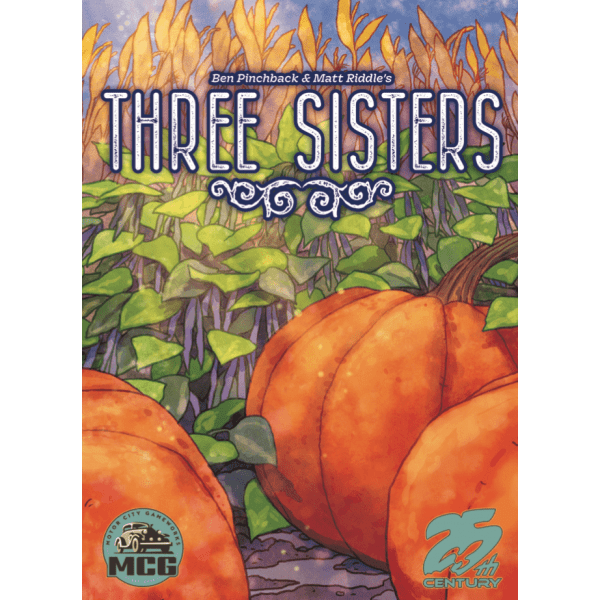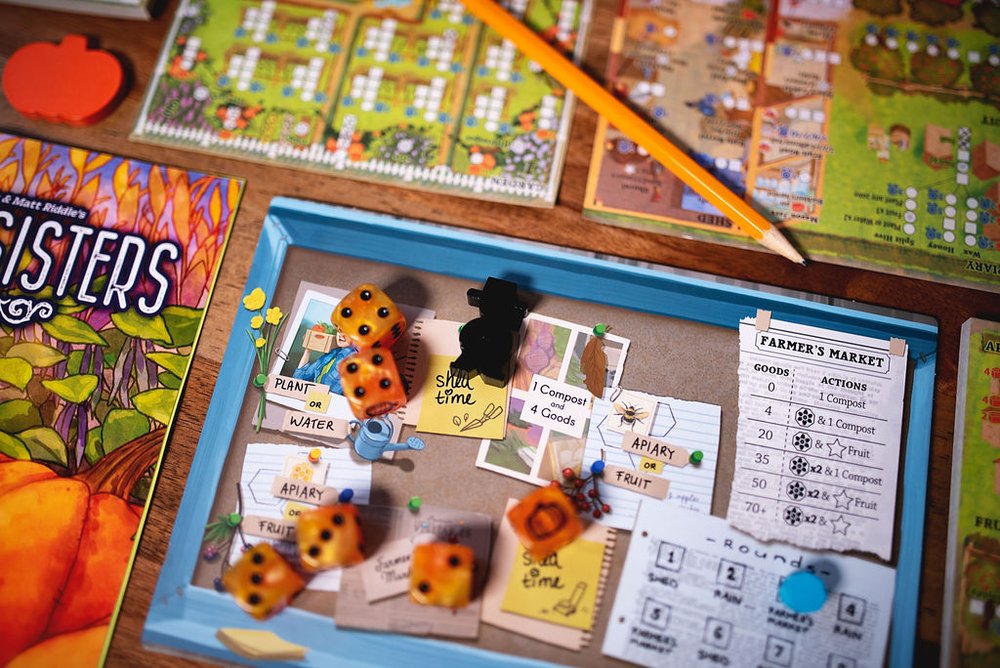Cultivate a Green Thumb in Roll-and-Write Game Three Sisters

Ben Pinchback and Matt Riddle return to the roll-and-write genre with Three Sisters from publisher 25th Century games.
Gameplay
Three Sisters is a simple to learn, yet hard to master roll and write game where creating the most effective and efficient engine will combo players into gardening success. Each player will take one of two different player sheets. The first sheet represents six sections of one’s garden containing pumpkins, corn, and beans, as well as rows of perennials. The second sheet has an apiary, shed, orchard, as well as goods and compost from which to choose and use.
The main action takes place around a rondel, where the dice (the number of which is dependent on player count) are rolled and placed on different areas, grouped by like rolls. These dice offer players to take the actions of the rondel areas while also working in their gardens. This is done through each turn, which consists of three phases: Planning, Gardening, and Event.
Player One will take the dice and roll them, placing them according to the position of the Farmer Edith pawn on the rondel. The lowest die (or dice) will take over the spot Farmer Edith inhabits, and then each space after will be occupied with the preceding die numbers, grouped by the same rolled face value. After all dice are placed, Farmer Edith is moved to the first empty clockwise spot on the rondel. The first player will then claim one of the dice from the rondel and begin by taking a Garden phase action.
In the Garden phase, players will use the die face value to plant up two crops in the corresponding garden section. For example, if a player took a die with the value of 4, they can start planting two crops in the 4 section of their garden with some caveats. For example, beans may not be planted until the corn stalks next to them are up to the second level. Players may also choose to water in the corresponding section, choosing to increase the column of all planted crops by one to represent them growing taller and closer to harvest.
After this action, players then use the location of where the die was taken to complete a different action. The spots include Plant and Water, which allows players to plant two additional crops or water all planted crops in the die face value section; Apiary or Fruit, which allows players to mark off the lowest/furthest left open space along the apiary or fruit tracks; the Shed allows players to mark off the furthest left open space along multiple tracks and activities that, once completed, can provide further bonuses such as end of game points, additional goods per harvests, and extra actions during the Garden phase; the 1 Compost and 4 Goods spot allows players to mark off four goods (starting from the furthest open left space) and add one pip to their compost section, which allows players to add or subtract pip values (depending on how many of the Compost pips they use on a turn) to manipulate the value of their chosen die; the Farmer’s Market spot allows players multiple options depending on how many goods they have acquired.
Finally, the Event phase occurs once all players have gone and all dice have been used. Players will look to the Round marker on the rondel and complete the action it allows, such as an additional Shed or Farmer’s Market action. There is also the Rain action, which occurs three times throughout the entire game. Rain allows players to do the water action across all sections within their gardens where crops have been planted.
As players continue through the rounds, they will begin to complete various crops in their gardens and earn immediate or game-ending points. Completing pumpkins provides players with goods. As players work up their goods tracks, each star marked off will provide players an immediate bonus action in the apiary, fruit, shed, or perennials. Completing two pumpkins that are adjacent will allow players to cross off and complete the perennial action space in between. Similar to the other action areas, completing perennial tracks will earn additional bonus and actions, and completed tracks will earn points.
This is also true of the apiary, fruit, and shed areas. The apiary becomes a forking path that allows players to chase points, some points and goods, or bonus actions to carry out in other areas of their sheets. There are four different types of fruit, each with their own benefits that can be bettered depending on finished shed items, which may mean gaining additional goods or actions.
After the eighth round, a final rain occurs and players carry out their final actions. Scores are tallied by counting up the number of corn (3 points each) and beans (1 point each) completed across garden sections, any points earned by finishing perennial tracks, points earned by advancing through the apiary and fruit tracks (including any bonuses earned via completed shed tracks), and any points awarded for finishing certain shed items. The player with the most points wins, with ties being broken by the player to earn the most from the garden.

Three Sisters rondel and scoresheets (photo provided by the publisher)
Review
Riddle and Pinchback are adept at making roll-and-write games that are easy to pick up and play, but provide a lot of variation based on the actions available and how they potentially interact to create satisfying combinations. At its heart, Three Sisters is an engine builder where players will seek the thrill of doing one thing to chase bonus actions and combos in other areas.
However, it’s very important to focus on the garden and the points it yields. While actions in the apiary, fruit, shed, and perennials tracks can provide points, much of the game’s points come from tending to one’s garden by planting and watering efficiently. Despite all the actions available, losing focus on the garden is certain defeat.
That said, in the way that the Ganz Schon Clever series and the pair’s own Fleet: The Dice Game entice players to think in terms of building an effective engine, there’s a certain enjoyment to just focusing on how one action in one area affects the other areas. It may not win you the game, but it will keep you engaged and entertained.
Speaking of engagement, despite many roll and writes feeling like solitary experiences, the way dice are used, claimed, and manipulated can cause some fun interactions between players who may otherwise be absorbed by their own sheets. And the art and design direction from Marlies Barends and Beth Sobel is equally engrossing. The fall colors of the sheets pop off the page and set the scene very well. All of this combines to provide a fun gaming experience where players also learn a little bit about gardening and how pairing pumpkins, corn, and beans allows a garden to thrive.
Pros: Intuitive rule book, lots of fun combinations to chase, engaging art and design
Cons: Not focusing on the garden often leads to certain defeat




